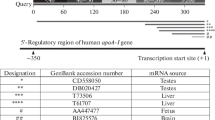Abstract
A site of rat DNA (about 1800 b. p.) adjacent to the first ceruloplasmin gene contains, apart from regulatory sequences common for all eukaryotic promotors, cis-elements, which are potential binding sites for soluble nuclear receptors of some hormones. Sequences characteristic of genes expressed in liver cells and mammary gland cells during lactation were detected. Full-length fragment of this locus of ceruloplasmin gene (1800 b. p.) was synthesized by PCR and used in gel shift experiments. It was found that soluble proteins extracted from purified nuclei of mammary gland cells during lactation and from the liver of adult and newborn rats, contain proteins specifically interacting with the PCR product. A fragment of chromosome gene containing exons encoding the central part of rat ceruloplasmin was cloned in pTZ19 bacterial vector. Gel shift assay showed that the cloned fragment contained binding sites for specific transcription factor YY1, whose level in nuclear protein fractions varied during ontogeny (according to immunoblotting data). Monoclonal antibodies detected protein YY1 in the complex of cloned DNA-nuclear proteins. Possible mechanisms of tissue-specific regulation of ceruloplasmin gene varying during ontogeny are discussed.
Similar content being viewed by others
REFERENCES
V. S. Gaitskhoki, O. V. Voronina, V. V. Denezhkina, et al., Biokhimiya, 55, 927–937 (1990).
L. V. Puchkova, T. D. Aleinikova, N. V. Tsymbalenko, et al., Ibid., 59, 341–348 (1994).
V. Babich, N. Aksenov, V. Alexeenko, et al., Gene, 239, 341–349 (1999).
P. J. Cervera, F. Mehrbod, S. J. Cotton, and M. C. Liner, Arch. Biochem. Biophys., 373, 451–461 (2000).
R. E. Fleming and J. D. Gitlin, J. Biol. Chem., 265, 7701–7709 (1990).
R. E. Fleming and J. D. Gitlin, Ibid., 267, 479–486 (1992).
E. D. Harris, Annu. Rev. Nutr., 20, 291–310 (2000).
N. E. Hellman and J. D. Gitlin, Ibid., 22, 439–458 (2002).
C. K. Mukhopadhyay, B. Muzumber, and P. L. Fox, J. Biol. Chem., 275, 21048–21054 (2000).
B. N. Patel, R. J. Dunn, S. Y. Jeong, et al., J. Neurosci., 22, 6578–6586 (2002).
Z. M. Qian and Y. Ke, Brain Res. Rev., 35, 287–298 (2001).
J. Sambrook, E. F. Fritch, and T. Maniatis, Molecular Cloning. Laboratory Manual, New York (1989).
D. Strausak, S. La Fontaine, J. Hill, et al., J. Biol. Chem., 274, 11170–11176 (1999).
Transcription Factors in Eukaryotes, Ed. A. G. Paparassioliou, Heidelberg (1997), pp. 4–30.
K. Umesono, K. K. Murakami, C. C. Thompson, and R. M. Evans, Cell., 65, 1255–1266 (1991).
Author information
Authors and Affiliations
Rights and permissions
About this article
Cite this article
Gyulikhandanova, N.E., Tsymbalenko, N.V., Platonova, N.A. et al. Regulation of Ceruloplasmin Gene in Mammals. Bulletin of Experimental Biology and Medicine 137, 485–489 (2004). https://doi.org/10.1023/B:BEBM.0000038160.60211.6f
Issue Date:
DOI: https://doi.org/10.1023/B:BEBM.0000038160.60211.6f




